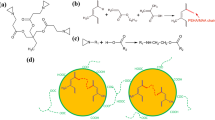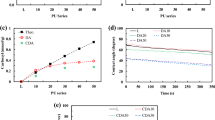Abstract.
Polyurethane (PU)/poly(acrylic rubber) (PAR) latex interpenetrating polymer networks based on waterborne PUs were prepared by sequential polymerization with methyl acrylate, ethyl acrylate, or butyl acrylate. The effect of PU/PAR composition and the cross-linking density in the PAR domain as well as in the PU domain has been studied in terms of density, mechanical, and dynamic mechanical properties in addition to the drying rate and the contact angle of the dispersion cast film with water. A high degree of interpenetrations was verified by mechanical properties showing positive deviation with a maximum from the additivity. In addition, incorporation with acrylate polymers having low glass-transition temperatures effectively augmented the hydrophobicity without sacrificing the elasticity of the original PUs. In addition, the acrylate monomers were polymerized by UV irradiation to significantly reduce the reaction time.
Similar content being viewed by others
Author information
Authors and Affiliations
Additional information
Electronic Publication
Rights and permissions
About this article
Cite this article
Kim, B., Shin, J. Modification of waterborne polyurethane by forming latex interpenetrating polymer networks with acrylate rubber. Colloid Polym Sci 280, 716–724 (2002). https://doi.org/10.1007/s00396-002-0672-5
Received:
Accepted:
Issue Date:
DOI: https://doi.org/10.1007/s00396-002-0672-5




